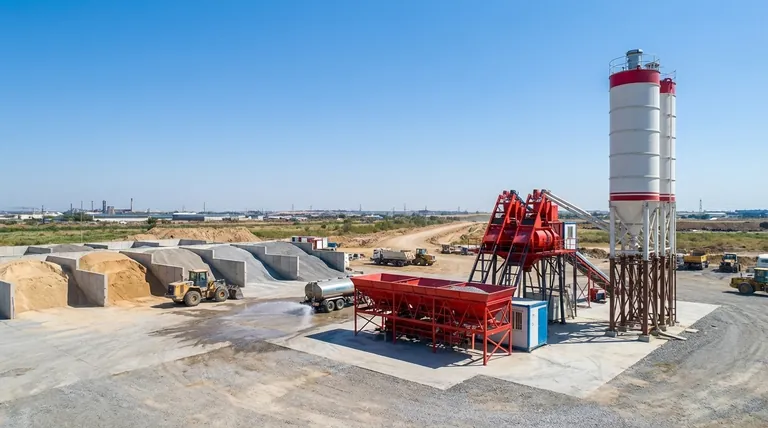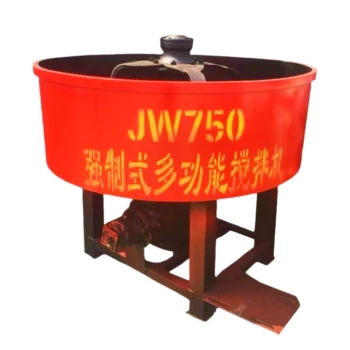In a concrete batching plant, materials are stored according to their physical properties and sensitivity to the environment. Aggregates like sand and gravel are typically kept in open-air stacks or bins, while fine powders like cement are protected in fully enclosed vertical silos. Chemical admixtures, which are liquids, are stored in separate, secure containers.
The storage strategy at a concrete plant is not just about warehousing materials; it is the first and most critical step in quality control. Each material's storage method is chosen specifically to prevent contamination, moisture damage, and degradation, ensuring every batch of concrete is consistent and meets design specifications.

The Role of Storage in Concrete Production
A concrete batching plant is a precision facility designed to combine sand, water, aggregates, and cement into concrete. It is not merely a mixing area but an integrated system where every step is controlled.
The process begins with the careful storage of raw materials. From storage, they are fed into the plant, accurately weighed, and then transferred to a central mixer. Proper storage ensures the materials entering this process are of a known and consistent quality.
A Breakdown of Material Storage Systems
The logic behind the storage system is simple: protect the integrity of each component before it enters the mix.
Aggregates (Sand and Gravel)
Aggregates are the most voluminous components and are generally stored in open-air stockpiles or separated bay bins.
Since they are relatively inert, direct exposure to the elements is less of a concern than for other materials. However, managing moisture content is still crucial.
For large-scale or high-specification commercial plants, aggregates may be stored in closed silos to provide superior control over moisture and prevent contamination.
Powders (Cement and Fly Ash)
Cement and other powdery materials like fly ash are the most sensitive ingredients. They are stored in tall, fully enclosed steel silos.
This isolation is non-negotiable. The primary goal is to protect these fine powders from any contact with moisture in the air, which can cause "pre-hydration" and render the cement useless. Silos also prevent the material from being lost to the wind.
Admixtures
Liquid chemical admixtures are stored in dedicated steel or plastic containers, often within a contained area.
These chemicals are used in smaller quantities to modify the properties of the concrete. Storing them in separate, labeled containers prevents cross-contamination and ensures accurate dispensing into the mix.
Common Pitfalls and Considerations
The effectiveness of a batching plant is directly tied to how well it manages its raw materials. Ignoring best practices in storage introduces significant risk.
The Impact of Moisture
Moisture is the single greatest threat to cement quality. Any uncontrolled moisture that reaches stored cement will reduce its strength and performance.
For aggregates, inconsistent moisture levels will alter the water-to-cement ratio of the final mix, which is the primary determinant of concrete strength. A plant must account for the water content in its aggregates to produce a consistent product.
The Risk of Contamination
Storing aggregates on unpaved or dirty ground can introduce clay, silt, or organic matter into the mix, weakening the final concrete.
Likewise, poor separation between different types of aggregates or powders can lead to an incorrect mix design being produced, failing to meet project specifications.
Applying This to Your Project
Understanding a plant's storage methodology can help you assess its quality control standards.
- If your primary focus is standard-grade concrete: A plant with well-organized open aggregate bins and clean, properly sealed cement silos is typically sufficient.
- If your primary focus is high-performance or specification-critical concrete: Look for plants that use closed aggregate storage to ensure superior control over moisture content and material consistency.
- If you are evaluating plant operations: Pay close attention to the separation between materials to prevent cross-contamination and ensure the integrity of stockpiles.
Ultimately, proper material storage is the foundation upon which every consistent and reliable batch of concrete is produced.
Summary Table:
| Material Type | Storage Method | Key Purpose |
|---|---|---|
| Aggregates (Sand, Gravel) | Open-air stockpiles or bins (closed for high-spec) | Manage moisture, prevent contamination |
| Powders (Cement, Fly Ash) | Fully enclosed vertical steel silos | Prevent pre-hydration from air moisture |
| Liquid Admixtures | Dedicated, labeled steel/plastic containers | Prevent cross-contamination, ensure accurate dosing |
Ensure your project's success with consistently high-quality concrete.
GARLWAY specializes in providing robust construction machinery, including advanced concrete batching plants designed with optimal material storage systems. Our solutions are engineered for construction companies and contractors globally who demand precision, reliability, and superior quality control.
Let us help you build on a solid foundation. Contact GARLWAY today to discuss your specific needs and discover the right equipment for your project.
Visual Guide

Related Products
- HZS120 Ready Mix Concrete Batching Plant Commercial Mud Cement Mixer
- JW1000 Mobile Cement Mixer Concrete Mixer Truck and Batching Plant
- Hydraulic Concrete Mixer Machine Cement Mixing Equipment for Mixture Concrete
- HZS75 Concrete Batching Plant Cement Mixer Price Concrete Mixer Bunnings Mixing Plant
- HZS35 Small Cement Concrete Mixing Batch Plant
People Also Ask
- How does ready-mix work? A Guide to Efficient, High-Quality Concrete Delivery
- What are the disadvantages of ready mix concrete? Navigating Logistical and Cost Challenges
- How does a ready-mix concrete plant work? A Guide to Efficient, High-Quality Production
- What are the advantages of concrete batching plant? Boost Quality & Efficiency for Your Project
- What are the advantages of a concrete plant? Achieve Consistent Quality & Efficiency for Large-Scale Projects














